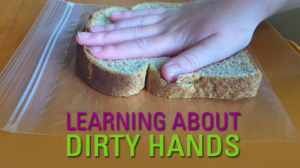 After spending some time at the playground, soccer field, or in the backyard, it can be easy to see the dirt on our hands. What you can’t see are the invisible-to-your-eye germs that accumulate on your hands throughout the day. To see the effect those germs have, give this this eye-opening experiment a try.
After spending some time at the playground, soccer field, or in the backyard, it can be easy to see the dirt on our hands. What you can’t see are the invisible-to-your-eye germs that accumulate on your hands throughout the day. To see the effect those germs have, give this this eye-opening experiment a try.
Spark you thinking!
1. Set up your science mini spark recording page: #5: Hand Hygiene Experiment
2. Read this whole page. On your recording page write down your plans the supplies you will need.
- Three slices of bread (the kind from a bakery or homemade works best — the fewer preservatives the better)
- Three resealable bags
- tongs (optional)
- Dirty hands
3. Gather your supplies and take a picture. Add it to your recording page.
4. Label each of the three bags:
-
- Control
- Dirty
- Clean
5. Place one slice of bread in the “control” bag without touching it. You can use clean tongs, or turn the resealable bag inside out and use it like a glove to get the slice inside. Seal the bag.
6. Remove a second slice of bread and touch the bread with unwashed hands. Place the bread in the bag and seal it.
7. Wash your hands with soap and water.
8. Take a third slice of bread and touch the bread with her freshly-washed hands. Place the bread in the bag and seal it.
9. Take all three sealed bags and put them in a cool, dry place.
10. Look at the bread daily and write down your observations, but do not take the bread out of the bags. In a few days, mold should start to appear.
11. Record the answers to these questions on your recording sheet.
- What slice of bread gets moldy first?
- Which grows the most mold?
- Which grows the least?
- If mold starts to appear, take a ruler and measure it and record your observations.
- Draw a picture of the bread each day, or keep a photo diary by taking pictures of the bread each day to watch the changes over time.
12. REMINDERS
You should wash your hands before, during, and after preparing food. Also wash before you eat, after using the restroom, after blowing your nose, after touching animals, and any time your hands appear dirty.
How Do I Wash? The scrubbing part of washing your hands is important. It’s the combination of the friction of rubbing your hands together along with the soap that really gets them clean. Take your time and sing or hum the Happy Birthday song twice. If soap and water are not available, use an alcohol-based hand sanitizer. Make sure it’s at least 60 percent alcohol. Rub the sanitizer all over your hands just like if you were scrubbing your hands with soap and water. Then allow the sanitizer to dry.
13. Share your science mini spark recording page with your teacher/EY coordinator.
Source: https://www.mottchildren.org/posts/camp-little-victors/dirty-hands
